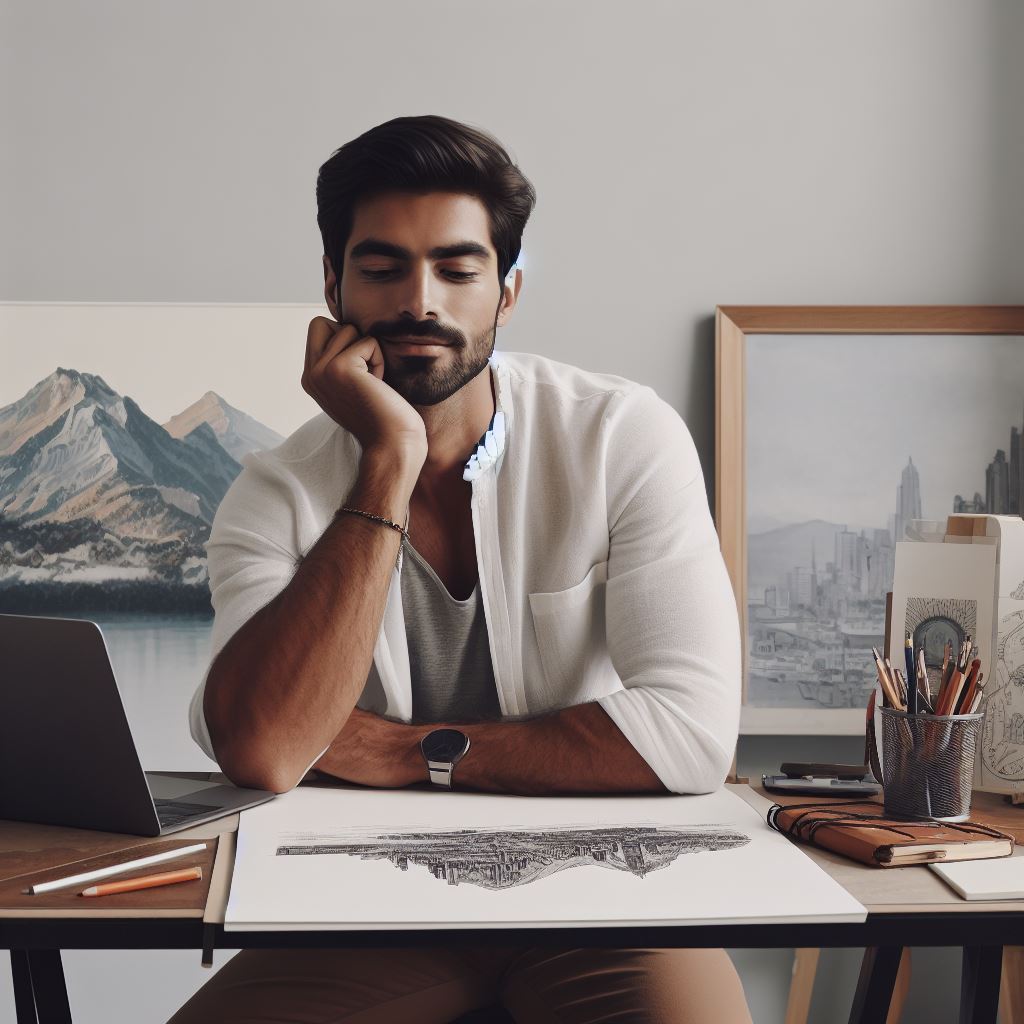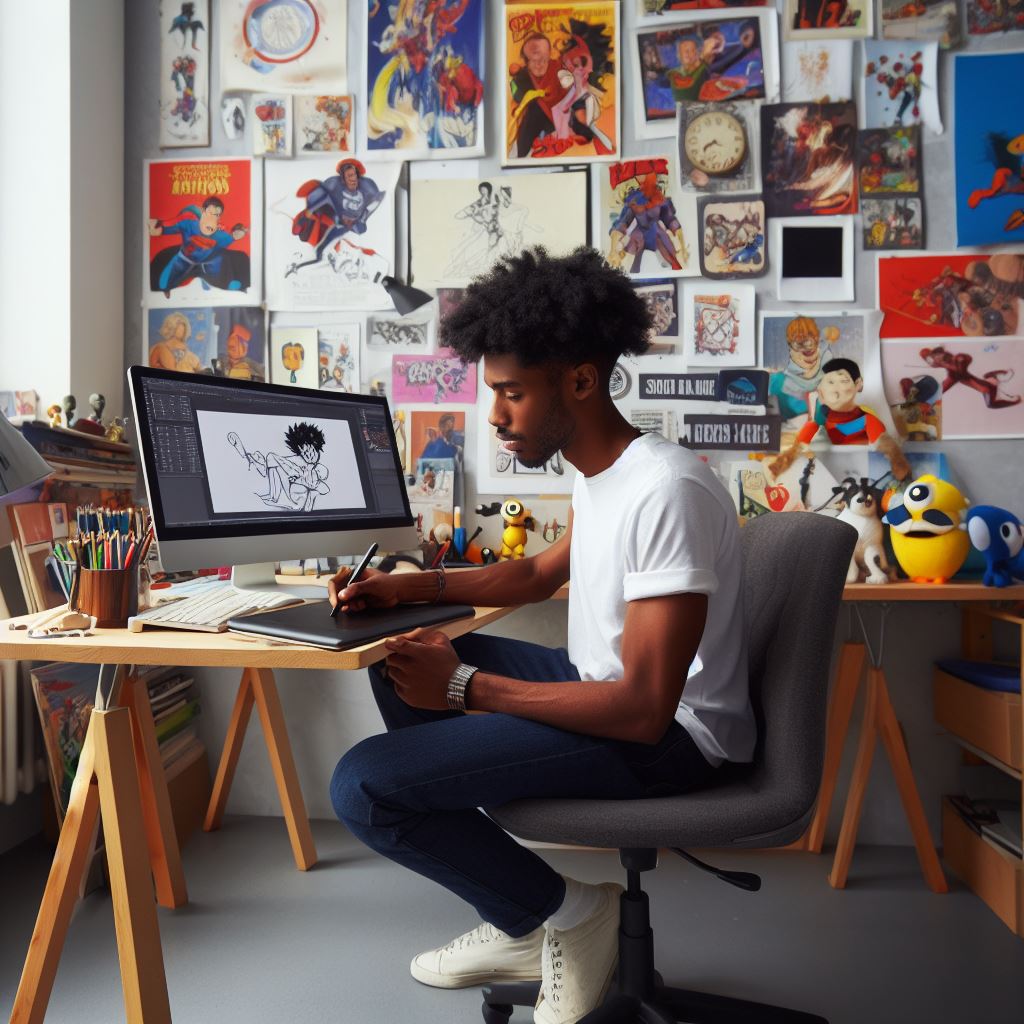Introduction
Diversity and representation in art spaces are crucial for fostering inclusivity and reflecting the richness of American culture. However, achieving true diversity in US art spaces presents a formidable challenge.
Addressing this challenge is vital to ensure equitable opportunities and to amplify underrepresented voices.
While strides have been made, there’s a persistent gap in representing diverse perspectives, backgrounds, and experiences.
The arts are powerful storytellers, shaping perceptions and influencing societal narratives.
Lack of representation not only marginalizes artists but also restricts the audience’s exposure to a spectrum of voices, hindering a comprehensive cultural dialogue.
This section explores the multifaceted challenge of diversity and representation in US art spaces.
It delves into the systemic issues that contribute to the underrepresentation of certain groups and discusses the impact on artistic expression and cultural understanding.
As we navigate the complexities of this challenge, it’s essential to analyze existing frameworks, acknowledge the progress made, and propose actionable steps for a more inclusive future.
The goal is not only to recognize diversity as a necessity but to actively implement strategies that reshape the landscape of US art spaces, making them truly reflective of the diverse tapestry of American society.
Historical Perspective on Diversity in US Art Spaces
In order to understand the challenges of diversity and representation in US art spaces today, it is important to examine the historical perspective.
Overview of past exclusionary practices in art spaces
- Art spaces in the past were often exclusionary, favoring a homogeneous representation.
- Minority artists and their works were marginalized, facing discrimination and limited opportunities.
- Art institutions, museums, and galleries predominantly showcased white artists and European art.
- Access to art education and resources was limited for minority communities and people of color.
Historical movements that fought for diversity and representation
- The Harlem Renaissance in the 1920s showcased the artistic achievements of African American artists.
- The Chicano Art Movement in the 1960s and 1970s highlighted the cultural experiences of Mexican Americans.
- The Feminist Art Movement in the 1970s challenged gender biases and male dominance in the art world.
- The Civil Rights Movement of the 1960s emphasized the need for equal representation and opportunities in all areas, including art.
Transition to current challenges in achieving true diversity and representation
- While progress has been made, there are still significant challenges in achieving true diversity and representation in US art spaces.
- Tokenism and performative gestures of inclusivity often overshadow genuine efforts for equity.
- Underrepresented artists continue to face barriers to entry, limited visibility, and unequal recognition.
- Art spaces struggle to dismantle ingrained structures that perpetuate exclusivity and favoritism.
- The lack of diversity in curatorial teams and decision-making positions hinders inclusive programming.
To address these challenges, a collective effort is required to transform the landscape of US art spaces.
Steps for achieving true diversity and representation
- Increasing the representation of marginalized artists through targeted exhibitions and acquisitions.
- Establishing mentorship programs and scholarships to support underrepresented artists.
- Collaborating with community organizations and cultural institutions to promote inclusivity.
- Enforcing diversity quotas and benchmarks for art spaces and institutions.
- Providing equal access to art education and resources for all communities.
- Promoting critical discussions and awareness around diversity and representation in the art world.
By adopting these steps and actively dismantling exclusionary practices, US art spaces can strive towards true diversity and representation.
Read: Cultural Influences in American Interior Design Trends
The Current State of Diversity in US Art Spaces
- Statistical data highlights the striking lack of diversity and representation in art spaces.
- Analysis reveals the underrepresentation of specific ethnicities, genders, and marginalized communities in the art world.
- It is crucial to emphasize the urgent need for the inclusion and recognition of diverse voices in art.
Art reflects society, yet diversity and representation in US art spaces fall short. Statistical data reveals stark underrepresentation, prompting critical examination.
ArtCensu$ survey shows 85% of major collections primarily feature white male artists, emphasizing exclusion of other ethnicities and genders.
Artists of color face barriers, not due to talent but systemic exclusion. Eurocentric art history marginalizes non-white artists, limiting recognition.
Gender disparities persist; women encounter limited opportunities and lower sales prices, perpetuating systemic inequalities within the art industry.
Marginalized communities, LGBTQ+, disabled, and indigenous populations, often remain invisible. Their stories and contributions lack platform and recognition, reinforcing homogeneity.
Art spaces must prioritize diversity and inclusion, reflecting society’s rich identities, giving marginalized voices a platform. Embracing diversity challenges norms and fosters dialogue.
Diverse art spaces benefit artists, visitors, and communities. Representation expands awareness, challenges biases, and fosters empathy, acting as catalysts for social change.
Transform Your Career Today
Unlock a personalized career strategy that drives real results. Get tailored advice and a roadmap designed just for you.
Start NowIn general, current diversity in US art spaces is unsatisfactory. Statistical data and analysis highlight underrepresentation, emphasizing the urgent need for change.
Read: Navigating Client Expectations: Tips for US Designers
Challenges and Barriers in Achieving Diversity and Representation
Addressing systemic biases and discrimination within art institutions
Art institutions have a responsibility to recognize and address the systemic biases and discriminatory practices that exist within their structures.
Without acknowledging these issues, achieving true diversity and representation becomes nearly impossible.
Institutions must actively work towards creating a more inclusive environment that values and uplifts artists from all backgrounds.
Factors contributing to the lack of diversity, such as financial barriers, limited access to resources, and biased selection processes
Financial barriers often prevent individuals from marginalized communities from accessing art spaces.
The high cost of materials, studio spaces, and education can create significant hurdles for artists who may already face socioeconomic challenges.
Limited access to resources further exacerbates these barriers, making it difficult for underrepresented artists to develop their skills and showcase their work.
Additionally, biased selection processes that favor certain styles or themes perpetuate the lack of diversity within art spaces.
The perpetuation of stereotypes and cultural appropriation that hinder representation efforts
The perpetuation of stereotypes and cultural appropriation further hinders representation efforts in art spaces.
Stereotypes limit artists to predefined narratives and narrow portrayals, suppressing their authentic voices and experiences.
Cultural appropriation, on the other hand, involves taking elements from marginalized cultures without proper understanding or respect, often commodifying and misrepresenting their traditions.
Both stereotypes and cultural appropriation reinforce existing power imbalances and prevent diverse perspectives from being heard.
These challenges and barriers are deeply rooted in the history and structure of art spaces and require deliberate effort to overcome.
Simply acknowledging the importance of diversity and representation is not enough ‘ actionable steps must be taken to create meaningful change.
Strategies for Overcoming Challenges and Achieving Diversity and Representation
Prioritize diversity at all levels within art institutions
Diversifying art institutions requires intentional efforts to include individuals from marginalized communities in all aspects of decision-making.
This includes diversifying boards, curatorial teams, and selection committees. By bringing in a range of perspectives, art spaces can better reflect the true diversity of the communities they serve.
Implement inclusive policies and initiatives
Art institutions should establish and enforce inclusive policies that promote diversity and representation.
This can include setting specific targets for showcasing underrepresented artists, allocating funds for scholarships or grants for artists from marginalized communities, and establishing mentorship programs to provide support and guidance to emerging artists.
Collaborate with community organizations and artists
Building strong partnerships with community organizations and artists from diverse backgrounds is essential.
Transform Your Career Today
Unlock a personalized career strategy that drives real results. Get tailored advice and a roadmap designed just for you.
Start NowBy actively engaging with these groups, art institutions can understand the specific needs and challenges faced by underrepresented communities and work together to create initiatives that address these issues.
Co-curating exhibitions or organizing community-driven projects can help foster trust and inclusivity.
Provide educational and professional development opportunities
Dismantling barriers to access is crucial for achieving diversity and representation.
Art institutions can offer scholarships, workshops, and residencies specifically targeted towards individuals from marginalized backgrounds.
This investment in education and professional development can empower aspiring artists to overcome financial constraints and gain the necessary skills and exposure to succeed in the art world
Achieving diversity and representation in US art spaces is an ongoing challenge that requires a comprehensive and sustained effort.
By addressing systemic biases, financial barriers, limited access to resources, biased selection processes, perpetuation of stereotypes, and cultural appropriation, art institutions can create a more inclusive and representative environment.
By implementing strategies that prioritize diversity, establishing inclusive policies, collaborating with community organizations, and providing educational and professional development opportunities, art institutions can begin to break down these barriers and foster a more equitable and vibrant art community.
Read: Future of Artistry: Digital Trends Shaping the US Art World
Initiatives and Efforts to Promote Diversity and Representation
1. Organizations, artists, and curators advocating for diversity and representation
Various organizations, artists, and curators are playing a crucial role in advocating for diversity and representation in US art spaces.
These individuals and groups are working tirelessly to challenge the status quo and create spaces that are inclusive and representative not only in terms of race and ethnicity but also in terms of gender, sexuality, disability, and other underrepresented identities.
2. Art spaces that have successfully embraced diversity and inclusion
Several art spaces across the US have successfully embraced diversity and inclusion by actively seeking out and uplifting marginalized voices.
These spaces serve as a beacon of hope and inspiration, demonstrating that art can be a powerful tool for social change and transformation.
3. The importance of public funding, grants, and scholarships to promote diverse artists
Public funding, grants, and scholarships play a fundamental role in promoting diverse artists and ensuring that they have equal opportunities to thrive in the art world.
These financial resources provide the necessary support for artists from marginalized backgrounds to access education, create their work, and exhibit in art spaces.
Read: Behind the Canvas: Day-to-Day Life of a US-Based Artist

Delve into the Subject: Steps to Become an Exhibition Designer
The Benefits of Diverse and Inclusive Art Spaces
Art is a reflection of society, and the challenge of diversity and representation in US art spaces is an important issue to address.
By creating inclusive and diverse art spaces, there are numerous benefits that can enhance creativity, innovation, and cultural conversations.
1. Enhancement of Creativity and Innovation
By embracing diversity and representation, art spaces open doors to new perspectives and ideas.
Transform Your Career Today
Unlock a personalized career strategy that drives real results. Get tailored advice and a roadmap designed just for you.
Start NowDifferent backgrounds and experiences can inspire artists to think outside the box, resulting in innovative and groundbreaking creations.
2. Enrichment of Art Narratives and Cultural Conversations
The inclusion of diverse voices allows for a more comprehensive and representative narrative.
When art spaces reflect the rich tapestry of cultures and experiences, they have the power to challenge stereotypes, bridge divides, and foster empathy.
3. Positive Impact on Audience Engagement
When viewers see themselves reflected in artworks and exhibitions, they feel a stronger connection and sense of belonging.
This leads to increased engagement and a greater overall appreciation for art, creating a more vibrant and inclusive arts community.
4. Fostering Cultural Understanding
Through diverse and inclusive art spaces, the understanding and appreciation of different cultures can grow.
Art becomes a vehicle for education, dismantling ignorance and fostering empathy and respect between diverse communities.
5. Promotion of Social Progress
Art has the power to provoke important conversations and challenge societal norms.
When art spaces are diverse and inclusive, they become platforms for addressing social issues, advocating for justice, and promoting positive change.
By embracing diversity and representation, art spaces become catalysts for change and empowerment. They play a crucial role in shaping and reflecting the values, beliefs, and aspirations of a society.
However, achieving diverse and inclusive art spaces requires deliberate efforts from artists, curators, and institutions.
6. Curatorial Responsibility
Curators must actively seek out and feature artists from underrepresented communities. They need to be intentional in their selection processes to ensure a diverse representation of voices and perspectives.
7. Artistic Collaboration
Artists should embrace collaboration across diverse backgrounds and disciplines. By working together, they can create powerful and insightful artworks that challenge norms and inspire change.
8. Accessibility and Outreach
Art spaces should prioritize accessibility, making sure exhibitions and events are inclusive to all visitors.
Outreach programs can also play a crucial role in engaging marginalized communities and fostering a sense of belonging.
9. Educational Initiatives
Integrating diversity and representation into art education is essential. By exposing students to a wide range of artists and perspectives, future generations can develop a deeper appreciation for diversity and inclusivity in art.
In essence, the benefits of diverse and inclusive art spaces are manifold.
From enhancing creativity and innovation to fostering cultural understanding and promoting social progress, inclusive art spaces have the power to transform society.
By embracing diversity, artists and institutions can create a more vibrant, representative, and meaningful art world for everyone to enjoy and participate in.
Learn More: Photographers’ Rights: Understanding US Copyright Laws
Transform Your Career Today
Unlock a personalized career strategy that drives real results. Get tailored advice and a roadmap designed just for you.
Start NowStrategies and Solutions for Increasing Diversity and Representation
Art organizations play a crucial role in fostering diversity and representation in US art spaces.
By implementing practical steps, educational programs, mentorship opportunities, and outreach initiatives, these organizations can ensure that art spaces become more inclusive and representative of diverse voices.
1. Practical steps art organizations can take to foster diversity and representation
- Establish diversity and inclusion committees to develop and implement strategies.
- Conduct regular diversity audits to assess the current state and measure progress.
- Implement transparent recruitment and hiring practices to attract a diverse pool of artists and staff.
- Provide training and resources to staff on cultural competency and anti-bias practices.
- Foster a welcoming and inclusive environment by promoting diversity in all aspects of the organization.
2. Educational programs, mentorship opportunities, and outreach initiatives
- Collaborate with educational institutions to develop art programs that target underrepresented communities.
- Create mentorship programs that connect established artists with emerging artists from diverse backgrounds.
- Organize workshops and seminars to provide access to professional development opportunities for artists of all backgrounds.
- Engage in outreach initiatives that specifically target underrepresented communities and encourage their participation in art spaces.
3. The importance of amplifying diverse voices through promotion, exhibitions, and artistic collaborations
- Feature diverse artists prominently in exhibitions and promotional materials.
- Celebrate and highlight diverse narratives and experiences through themed exhibitions.
- Collaborate with diverse communities and artists to co-create exhibitions and art projects.
- Provide platforms for dialogue and discussions on diversity and representation in art through panel discussions and forums.
- Support and promote cross-cultural artistic collaborations to foster understanding and appreciation of diverse perspectives.
Art organizations can actively increase diversity by fostering inclusivity, implementing transparent recruitment practices, and offering cultural competency training.
Establishing diversity committees and regular audits allows organizations to track progress in implementing initiatives effectively.
Educational programs, mentorship, and outreach initiatives are essential for cultivating talent from underrepresented communities.
Collaboration with educational institutions and providing resources nurtures emerging artists, supporting their thriving in the art world.
Promoting diverse voices through exhibitions, collaborations, and promotional materials is crucial for breaking down barriers in art spaces.
Featuring diverse artists and creating dialogue platforms fosters understanding, appreciation, and engagement with diverse perspectives.
Increasing diversity requires proactive efforts. Art organizations can create inclusive spaces by implementing practical steps, educational programs, and outreach initiatives.
Through collective efforts, the art world can reflect the true diversity and richness of the society it exists within.
Conclusion
The challenge of achieving diversity and representation in US art spaces is undeniable. Despite efforts to address the issue, the art world still struggles with inclusivity and equity.
It is crucial to emphasize the importance of collective efforts in creating inclusive and equitable art environments.
In order to address this challenge, it is necessary for artists, curators, and art institutions to work together to dismantle systemic barriers and biases.
While progress has been made in recent years, there is still a long way to go. The potential for change and progress in the art world is enormous, and it is up to all of us to drive it forward.
It is crucial for art spaces to recognize and value the contributions of artists from diverse backgrounds, ensuring their voices are heard and their work is given equal visibility and opportunities.
This requires a commitment to representation that goes beyond tokenism and superficial gestures.
To truly address the challenge of diversity and representation, art spaces must actively engage with communities, listen to their concerns, and actively work towards creating a more inclusive and equitable art world.
By embracing diversity and challenging traditional power structures, art spaces have the potential to become vibrant spaces for dialogue, empowerment, and social change.
We must continue to push for progress and hold ourselves accountable in order to create a more inclusive and representative art world for all.




